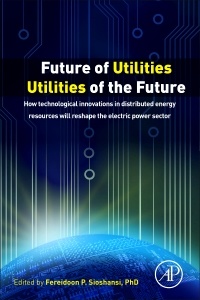Future of Utilities - Utilities of the Future How Technological Innovations in Distributed Energy Resources Will Reshape the Electric Power Sector
Coordonnateur : Sioshansi Fereidoon

Future of Utilities - Utilities of the Future: How technological innovations in distributed generation will reshape the electric power sector relates the latest information on the electric power sector its rapid transformation, particularly on the distribution network and customer side. Trends like the rapid rise of self-generation and distributed generation, microgrids, demand response, the dissemination of electric vehicles and zero-net energy buildings that promise to turn many consumers into prosumers are discussed.
The book brings together authors from industry and academic backgrounds to present their original, cutting-edge and thought-provoking ideas on the challenges currently faced by electric utilities around the globe, the opportunities they present, and what the future might hold for both traditional players and new entrants to the sector.
The book's first part lays out the present scenario, with concepts such as an integrated grid, microgrids, self-generation, customer-centric service, and pricing, while the second part focuses on how innovation, policy, regulation, and pricing models may come together to form a new electrical sector, exploring the reconfiguring of the current institutions, new rates design in light of changes to retail electricity markets and energy efficiency, and the cost and benefits of integration of distributed or intermittent generation, including coupling local renewable energy generation with electric vehicle fleets.
The final section projects the future function and role of existing electrical utilities and newcomers to this sector, looking at new pathways for business and pricing models, consumer relations, technology, and innovation.
Part I. What is changing and what are the implications 1. What future for electric power sector 2. The value of an integrated grid 3. Microgrids: Finally finding their place 4. The new power on the consumer side of the meter 5. A customer-centric view of electricity service 6. The role of the utility and pricing in the transition
Part II. Innovation, policy, regulations, pricing 7. Regulation for a sustainable energy system – reconfiguring the institutions 8. Rate design of the future 9. Rates and revenues: Differential impacts of customer-sited distributed generation in vertically-integrated and competitive retail markets 10. Rehabilitating Retail Electricity Markets: Pitfalls and Opportunities 11. Assessing the Cost and Benefits of DER Integration 12. Efficiency and equity considerations in designing rates in the context of the death spiral for electric utilities 13. Modeling the impacts of disruptive technologies and pricing on peak demand 14. Intermittency – it’s the short-term that matters 15. Opportunities and challenges in coupling local renewable energy generation with EV fleets
Part III. Function and role of the utility of the future – or the future of utilities 16. Identifying value pools, building new business models, and defining strategies rooted in inherent capabilities in utilities 17. Utilities don’t simply connect, they integrate 18. Smart, renewable or decentralized: Strategic choices of European energy incumbents 19. Imagine a future where entrepreneurial, profitable utilities thrive despite disruptive technologies: German case study 20. The future of utility customers and utility customers of the future 21. Flexibility business models: new actors, new roles, new rules 22. Decentralized reliability options – market based capacity arrangements 23. Network pricing for the prosumer future: Demand-based tariffs or nodal pricing? 24. The evolution of smart grids begs disaggregated nodal pricing 25. The distributed utility: Conflicts and opportunities between the incumbent utilities, suppliers and the emerging new entrants 26. Innovation platform enables the Internet of things
- Contains discussions that help readers understand the underlying causes and drivers of change in the electrical sector, and what these changes mean in financial, operational, and regulatory terms
- Provides thought-provoking ideas on the challenges currently faced by electric utilities around the globe, the opportunities they present, and what the future might hold for both traditional players and new entrants to the sector
- Helps readers anticipate what developments are likely to define the function and role of the utility of the future
Date de parution : 03-2016
Ouvrage de 492 p.
15x22.8 cm
Thèmes de Future of Utilities - Utilities of the Future :
Mots-clés :
as a service; autonomous production; batteries; battery storage; business models; capacity remuneration mechanisms; centralized generation; clean energy; connectivity; contract design; cooperation; cultural change; customer; customer choice in electricity; customer preferences; demand-based tariff; DER distribution system impacts; DER integration; digitalization; disaggregated nodal pricing; distributed energy; distributed energy resources (DERs); distributed generation; distributed resources; distributed utility; distribution expansion planning; distribution network tariffs; dynamic retail prices; education; electric power sector; electricity demand; electricity grid; electricity market restructuring; electricity tariffs; embedded generation; flexibility; generalized merit order; generation adequacy; grid integration; grid modernization; hedging locational pricing risk; home battery; innovation; integrated grid; internationalization; Internet of Things (IoT); liberalized electricity markets; locational marginal pricingvof distribution networks; market design; market structure; Maslow; microgrids; net-metering; new entrants; personal energy; power electronics; power quality; power system flexibility; pricing; product differentiation; prosumers; PV impacts on distribution systems; rate design; reliability; reliability options; renewable intermittency; resilience; restructuring; retail choice; retail electricity providers (REPs); retail market competition; smart appliances; smart grids; solar; solar intermittency; solar PV; solar PV arrays; storage; strategy; technological innovation; Texas electricity market; third platform; transactive energy; transformation; transmission level visibility; utilities; utility; utility business models; utility future; utility strategy; value; value of the grid; vision; wholesale/retail integration



